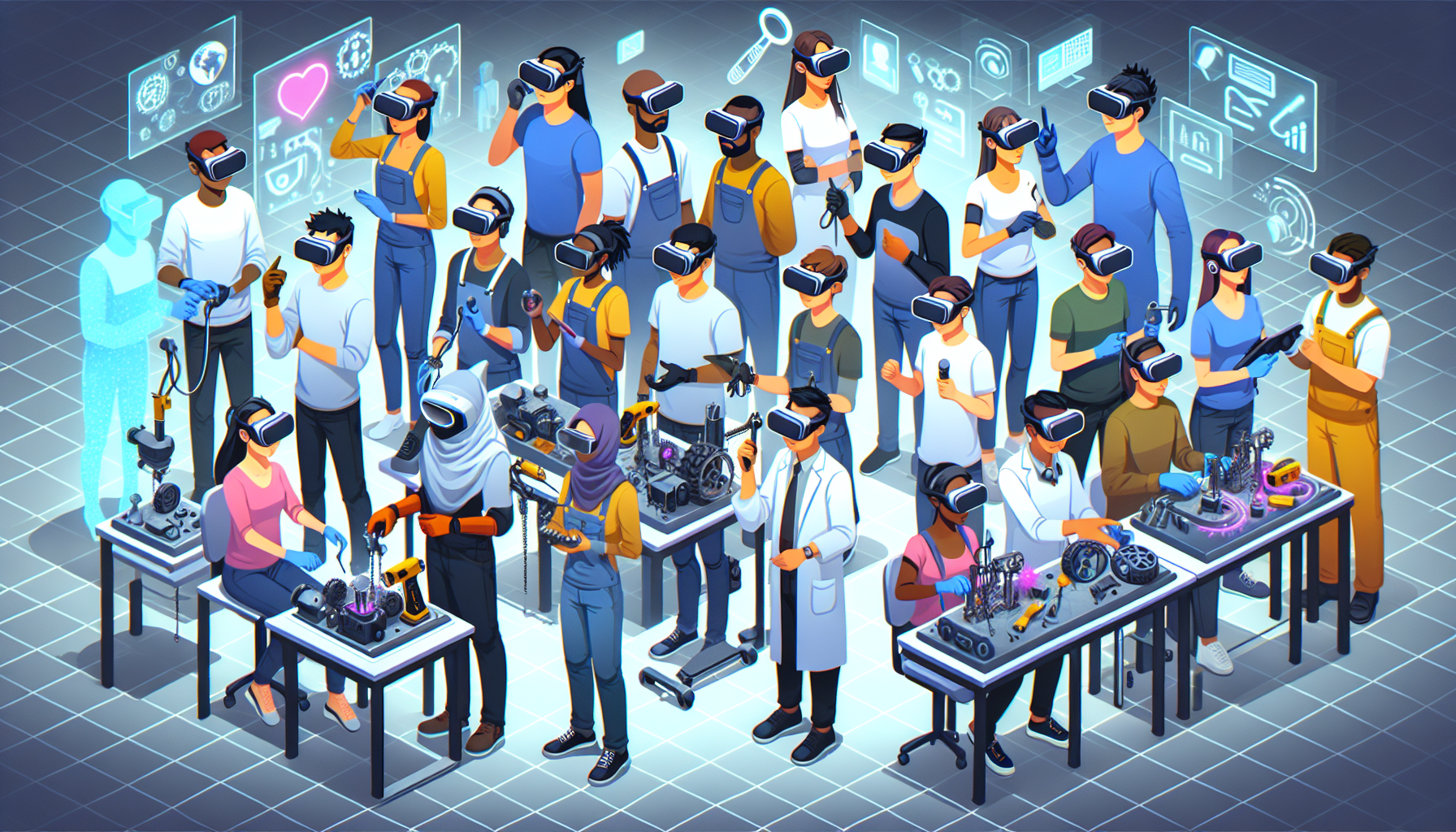What makes interactive training an essential update to conventional learning methods? It’s the increased engagement, improved retention, and adaptability to individual needs. In this article, you’ll uncover the core elements that make interactive training effective and explore strategies to implement it efficiently, ensuring your learning programs are as dynamic as your learners.
Key Takeaways
- Interactive training enhances engagement, motivation, knowledge retention, and accommodates diverse learning styles by using hands-on methods such as quizzes, simulations, and role-plays, which are critical for effective learning, especially for remote workers.
- Effective interactive training programs should combine key components such as a blended learning approach, personalization, adaptability, collaboration, and the use of gamification and multimedia integration for an engaging learning experience.
- Evaluating the effectiveness of interactive training programs is essential, involving tracking learner progress, gathering feedback, and analyzing training data, while designing programs requires addressing challenges like balancing interactivity with content, ensuring accessibility, and managing time and resources.
The Power of Interactive Training
Imagine yourself fully immersed in a training program that captivates, motivates, and adapts to your individual learning style, this is the essence of interactive training. Infusing dynamic elements into educational modules creates an engaging atmosphere for learners, resulting in more impactful and memorable lessons. This approach proves especially beneficial for remote workers as it offers them a comprehensive learning experience that surpasses traditional methods. Some advantages of incorporating interactivity into training are:
- Increased engagement and motivation levels
- Improved retention rates of acquired knowledge
- Enhanced problem-solving abilities and critical thinking skills
- Real-time evaluation opportunities
By infusing interactive elements into your training initiatives, you can create a lively environment where employees acquire new skill sets effectively.
Such innovative programs accommodate diverse preferences by including hands-on techniques like simulations or role-playing exercises which over 80% percent of survey takers view positively indicating their widespread acceptance. The end result? A complete package tailored towards varied learner profiles provides ample scope to hone existing capacities while amplifying others through proper guidance.
Interactive online forms aid even more. As they facilitate interaction with educators, they foster better understanding amongst participants thus improving memory longevity. Overall spurring creativity makes the platform an unrivaled tool not just during current circumstances but likewise going forward enhancing value extraction exponentially from seemingly “mundane” tasks.
Engagement and motivation
Engagement and motivation are crucial factors in any training course, including interactive ones. Integrating a variety of elements like quizzes, gamification, impactful videos, rewards through certificates and leaderboards into the training courses can effectively engage learners. By incorporating game-based learning techniques to reinforce new skills, interactive training software helps sustain learner interest while making the process enjoyable.
However, it is essential to find a balance between the complexity of the material being taught and the abilities of learners to avoid causing frustration or boredom. In online training sessions, there was a lack of knowledge.
Knowledge retention
Interactive training has a major advantage in its ability to improve retention of knowledge. By actively involving learners during the learning process through interactive training sessions, their capacity to retain information is significantly enhanced. The practice of incorporating interactive reinforcement by posing questions related to previously covered material strengthens understanding and makes the overall training more effective.
Assignments can serve multiple purposes such as reinforcing learned material, identifying areas where Knowledge may be needed, assessing learner comprehension of course materials, and ultimately contributing towards better retention of information.
Adding interactive presentations can also enhance the overall learning experience even further. For instance, EdApp’s Assignments feature includes a question-and-response tool that allows for self-testing on key concepts and evaluation of knowledge retention.
Adapting to different learning styles
Every individual has their own unique learning style and preferences. Interactive training recognizes this diversity and offers a variety of methods to accommodate each learner, creating an inclusive environment for learning.
Social learning in interactive training encourages learners to work together and share knowledge, ultimately enhancing the overall experience through collaboration.
Integrating multiple approaches in interactive training engages a wider range of employees with diverse needs, resulting in a well-rounded and effective approach to learning.
Key Components of Effective Interactive Training Programs
After understanding the potential of interactive training, it’s important to explore the key components that contribute to its effectiveness. An effective interactive training program goes beyond just incorporating interactive elements. Instead, it combines a variety of factors such as a blended learning approach, personalization, adaptability and collaboration.
The success of an interactive training program depends on achieving personalized learning experiences for individuals by offering incentives and rewards. These motivate learners and create excitement which in turn enhances engagement with the materials provided. Additionally, this also allows learners to customize their own paths towards better adaptation during the process. Training can be made more fun through gamification techniques where game elements are integrated into traditional modules. This makes sure that enjoyment is added alongside increased efficiency when carrying out certain tasks. It thus becomes easier for participants or trainees to do different kinds of practical activities while undergoing valuable instructions online.
In conclusion, a successful interactional program relies heavily on creating opportunities for engaging participation among members taking part. Strong achievement systems play perfectly with all this.It starts from utilizing both old school methodologies like blending e-learning mode alongside improving one’s skills via adopting fresh utilization so games will increase fun levels making whole procedures simpler and more comprehensive. Henceforth, efforts need to be made in order to bring back attention span connections between trainers, the material plus being educated.
Blended learning approach
Blended learning is a powerful tool in interactive training that combines traditional classroom techniques with online resources and virtual interactions to create an engaging and diverse learning experience. This approach offers several benefits, including the flexibility for learners to pace themselves, time-saving through access to online materials, increased engagement and motivation, improved retention of knowledge, enhanced accessibility conditions for participants, and effective targeting of specific audiences. Additionally, it integrates different methods of instruction, which reinforces overall learning.
Effective blended learning programs in interactive training may involve strategies like incorporating stations or labs into face-to-face sessions as well as utilizing a flipped classroom model where students prepare prior to attending class. By providing various modes of instruction tailored to individual preferences, the result is an all-encompassing educational experience catering specifically to each learner’s unique needs.
Personalization and adaptability
Interactive training is primarily defined by its ability to be tailored and flexible. This empowers learners to progress at their own pace and focus on areas that require improvement, resulting in personalized learning experiences and positive outcomes.
Personalization refers to the adaptation of the learning experience according to individual needs, preferences, and unique ways of absorbing information. It ensures that the material presented is relevant and delivered in a manner that keeps learners engaged or accessible for them. On the other hand, adaptability enables trainers to respond effectively not only to different learner requirements but also to unexpected obstacles during teaching sessions. With this feature, both educators can address individual student’s concerns while attending to group needs simultaneously.
Collaboration and social learning
Collaboration and social learning play a crucial role in interactive training. These methods foster teamwork, communication, and peer-to-peer support, which enriches the overall learning experience. One example of this is EdApp’s Discussions tool which allows learners to start discussions about course content and give immediate feedback to their peers, creating an environment for collaborative learning.
Interactive training programs incorporate social learning through various activities such as asking questions, working on group projects together, participating in interactive discussions or using computer-based tools like blogs. All these activities promote a sense of community among learners and contribute towards enhancing their overall learning experience.
Incorporating elements of collaboration and social interaction into training has shown significant benefits in shaping a positive learner environment where individuals can learn from each other effectively. Engaging students actively with one another through different forms of participation within the program fosters not only improved knowledge retention, but also creates meaningful connections between trainees, ultimately contributing significantly toward improving traditional methods over time.
Implementing Interactive Elements in Training Modules

One crucial concern is how to integrate interactive elements into online training modules for a more engaging learning experience. The combination of multimedia, gamification, and real-world scenarios can create immersive and captivating learning opportunities. Integrating characters as virtual tutors or peers adds a valuable communication element often lacking in traditional online courses. Using 360° videos enables learners to control their environment through virtual tours that introduce them to the workplace before VR training.
Incorporating game-like features such as rewards, badges, points, and leaderboards – commonly known as gamification – helps increase motivation and engagement in training activities. Meanwhile, simulations of authentic situations allow participants to practice decision-making without consequences in simulated environments. It also challenges critical thinking skills by offering multiple scenario options with personalized feedback on decision-making – effectively preparing individuals for real-life encounters.
These strategies are highly effective when it comes to developing essential skills and readiness for actual situations. With an emphasis on creating simulations, the incorporation of these interactive elements into training modules plays a significant role in enriching the effectiveness of online learning experiences. This goes beyond traditional forms of training to help build competent professionals who are better equipped to deal with complex challenges they may face in the future. Through this approach, intensive learning can be achieved without having to physically present training sessions.
Multimedia integration
The effective integration of multimedia in training modules adds a dynamic element and enhances visual appeal. This includes incorporating videos, graphics, and animations to provide diversity and make the content more engaging. Elements like flowcharts and diagrams help simplify complex concepts, while interactive features such as quizzes and games boost engagement levels within eLearning programs.
Incorporating video content into interactive training modules offers numerous benefits. Microlearning allows for shorter videos that are easier to absorb without overwhelming learners. These videos can serve as valuable performance support tools by providing relevant information in a timely manner for employees on the job.
Gamification and game-based learning
In the world of interactive training, gamification and game-based learning have proven to be powerful tools. Gamification is when a traditional learning process is transformed into an engaging game, while game-based learning involves incorporating games directly into the teaching method. Through these approaches, collaboration, teamwork, and quick decision-making are promoted in order to make the overall experience of training both enjoyable and effective.
Some common examples of using games for educational purposes include adapting popular TV shows like Jeopardy or utilizing simple video games such as Minesweeper. To this type of practice through playing digital media, simulations also offer practical opportunities for hands-on experiences – whether it’s role-playing managing upset customers or troubleshooting complex software issues – that help enhance problem-solving skills within real-life scenarios.
Real-world scenarios and simulations

Interactive training allows learners to gain practical experience through simulations and real-world scenarios, enabling them to apply their knowledge and skills in authentic situations. Different approaches can be used for developing realistic scenarios that enhance learning, such as using simulation-based techniques or immersing learners in actual experiences.
One of the key benefits of these methods is providing a risk-free environment where individuals can practice without consequences. This enables them to develop confidence while honing their abilities. Incorporating various types of simulations – including live, system, virtual, and immersive – offers learners a diverse range of opportunities to engage with material.
Through interactive training sessions utilizing different categories of learning simulations mentioned above-mentioned ones. Participants are able to immerse themselves fully in hands-on activities tailored specifically towards their individual needs. These include creating an atmosphere filled with life-like events replicated from reality among other fascinating strategies which will drive home essential ideas about whatever concept they want sharpened.
Evaluating the Effectiveness of Interactive Training
One important consideration after implementing the interactive training program is determining its effectiveness. This involves monitoring learner advancement, obtaining input from participants, and examining data to pinpoint areas for enhancement and guarantee successful training outcomes. These factors play a critical role in refining and improving the overall quality of the training program by providing valuable insights on how to improve learning results.
Tracking learner progress
To determine the effectiveness of interactive training, it is crucial to keep track of learner progress. This allows for the identification of any gaps in knowledge and performance monitoring, as well as providing personalized support to enhance the learning experience. Through learning analytics, educators and trainers can easily monitor individual student progress and pinpoint areas where learners may be facing challenges or falling short in their proficiency levels. By uncovering these knowledge gaps through tracking learner progress, necessary measures can be taken to address them.
There are several recommended tools that one can use for tracking learner progress in online interactive training courses such as Learning Management Systems (LMS) like Schoox, Absorb LMS LearnUpon modONE Cornerstone LMS DigitalChalk eFront TalentCards,and engagement platforms including DegreeSight and Kahoot! These resources provide a comprehensive overview of each student’s performance level enabling targeted interventions when needed.
Gathering feedback
Feedback plays a critical role in interactive training, just as it does in any learning process. Gathering feedback from both learners and facilitators is essential for continuously improving and refining the training program. Various effective methods like surveys, interviews, and focus groups can be used to collect feedback while ensuring anonymity to encourage honest responses. Such inputs provide valuable insights into identifying the strengths and weaknesses of the training program.
The utilization of feedback is vital for enhancing the quality of interactive training materials. It enables an evaluation of learning outcomes as well as the identification of areas that need improvement in terms of content relevance and delivery techniques. This information gathered through various forms of feedback can then be utilized to refine and enhance future sessions’ materials, paving the way for better learning experiences during training programs.
Analyzing training data
Evaluating the effectiveness of interactive training involves examining data to identify trends, patterns and areas for improvement. This is crucial in ensuring the continued success of a training program that utilizes interactivity. Effective methods for collecting relevant data include surveys, interviews, focus groups, observations and assessments.
To thoroughly analyze interactive training programs, requires gathering various types of information such as learner engagement levels, course completion rates and assessment scores. Additional important metrics are time spent on different activities by learners, their feedback through forms or self-reports, and performance progress over time. These valuable insights provide an understanding of how participants interact with the materials presented during their learning experience, which can inform future enhancements to optimize results.
Analyzing these essential data points from interactive training helps reveal significant patterns that aid in refining the learning process while also predicting potential outcomes. The aim is to improve upon existing methods utilized within current courses. This ongoing evaluation ensures effective implementation moving forward creating high-quality experiences catered to each individual’s unique needs. Additionally, it allows trainers/educators chances to modify certain approaches if necessary based on findings related to directly gathered metrics. Such adjustments guarantee constant advancement perpetually.
Overcoming Challenges in Designing Interactive Training Programs
Developing a successful interactive training program can be difficult, despite its many advantages. Achieving the right balance between engaging activities and valuable content is one challenge that must be addressed. Making sure the program is accessible to all participants and effectively managing time and resources are other obstacles that need to be tackled.
It’s important to acknowledge these challenges in order for us to find effective solutions. By strategizing on how best to address them, we can create an impactful training experience for our audience while also meeting their learning needs.
Balancing interactivity and content
Balancing interactivity and content is a key challenge when designing interactive training programs. While learner engagement and retention can be enhanced through interactivity, too much of it may lead to confusion, complexity, and frustration among learners.
To achieve an optimal balance between these two elements, clear learning objectives should be established along with appropriate delivery mode and format selection. Engaging yet not overwhelming content must be created by strategically incorporating interactive elements as well as multimedia features in modules that are mobile device-friendly.
Ensuring accessibility
One of the main challenges in implementing training programs that involve interactive elements is making sure they are accessible to all learners. This includes ensuring that standard or adaptive input devices and technologies can be used by participants, as well as providing keyboard accessibility for text and having alternative options for controls.
To ensure inclusivity, it’s important to consider the needs of individuals with disabilities or limited access to technology. This may involve including captions or transcripts for audio content, using visual aids alongside auditory information, giving clear written instructions, and allowing one-on-one interactions for those with hearing impairments.
Managing time and resources
Efficient management of time and resources is crucial for the successful implementation and maintenance of interactive training programs. To achieve this, here are some recommended techniques:
- Clearly define goals and priorities
- Establish a structured schedule
- Utilize tools for managing time effectively
- Encourage a continuous learning mindset
Optimal allocation of resources can be accomplished through the use of resource allocation software and other interactive training tools. It is imperative to have a clear understanding of organizational objectives, strategically manage trainers and venues, as well as provide user guides and videos as learning materials in order to efficiently allocate necessary resources.
Summary
Interactive training has revolutionized the learning landscape by making it more engaging, adaptable, and effective. It offers tremendous benefits, including enhanced engagement, improved knowledge retention, and adaptability to different learning styles. An effective interactive training program incorporates a blend of online and traditional learning methods, personalization, adaptability, and collaboration. To ensure its ongoing success, it’s crucial to evaluate its effectiveness regularly by tracking learner progress, gathering feedback, and analyzing training data. Overcoming challenges such as balancing interactivity and content, ensuring accessibility, and managing time and resources are also vital for its successful implementation.
Frequently Asked Questions
What is an interactive training?
Interactive training refers to a method of learning where both the trainer and employee or course module and learner, actively participate in the process. This can involve various forms such as group activities, simulations, games, quizzes and assessments to keep participants engaged. The main purpose is for employees to be fully immersed in their learning experience.
How do you conduct interactive training?
To ensure an interactive training session, incorporate ice-breakers and energizers, foster a positive group dynamic, adequately prepare beforehand, and encourage collaboration among participants. This strategy will result in a stimulating and successful learning environment for all involved.
What are the key components of an effective interactive training program?
A successful training program must incorporate a combination of learning techniques, customization for individual learners, flexibility to adjust to various situations, and opportunities for collaboration in order to achieve the highest levels of involvement and knowledge retention.
How is the effectiveness of interactive training evaluated?
Evaluating the success of interactive training involves monitoring learner advancements, obtaining input, and examining data from the training. This aids in assessing its effectiveness and identifying any potential areas for enhancement.
What challenges might be faced when designing interactive training programs, and how can they be overcome?
When designing interactive training programs, challenges such as balancing interactivity and content, ensuring accessibility, and managing time and resources may arise. These can be overcome by establishing clear learning objectives, selecting appropriate delivery modes and formats, ensuring keyboard accessibility, and utilizing efficient time management methodologies.







